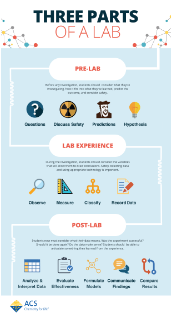Laboratory Experience
Chemistry is a laboratory science and cannot be effectively taught without a robust laboratory experience for students at both the middle and high school levels. The identification, manipulation, and general use of laboratory equipment are integral parts of the subject. A school laboratory should have equipment to conduct meaningful demonstrations and experiments.
The laboratory environment must be accessible to all students and maintained with safety in mind. Teachers should use safety measures to protect students and themselves during any investigation. With appropriate accommodations, students with limited strength or mobility can participate in the laboratory experience.
Three Parts of Lab
Instruction that is student-centered and emphasizes the role of laboratory demonstrations and experiments is the best method to ensure students develop the essential skills of science. Laboratory investigations should come in three phases: the pre-lab, the lab experience, and the post-lab.
1. Pre-Lab
In the pre-lab, students should consider the concept or principle to be investigated. This gives them the opportunity to make predictions and hypotheses. Effective pre-lab questions can prompt students to review and recall previously learned concepts that are pertinent to the investigation. This is also an opportunity to discuss safety protocols for the lab and introduce any new lab equipment they will use.
2. Lab Experience
The lab experience allows students to learn how to plan their actions and to identify and control variables. During the investigation, they will observe, measure, classify, and record data. They must conduct all labs following safety guidelines. Incorporating technology into lab investigations may enhance how students collect and manipulate data (see Technology in the Lab).
3. Post-Lab
The post-lab provides an opportunity for students to analyze and interpret data, evaluate the effectiveness of the procedure, formulate models, and communicate their findings in written and oral formats. Students can also relate or compare results and concepts with classmates and to previously learned phenomena. It’s important to emphasize during this part that collecting the same data does not mean final reports will be the same; there’s a difference between collaborating and copying. Each student will grapple with the data a little differently and express their findings using their own voice. The post-lab is also a time for students to evaluate the safety guidelines that were presented in the pre-lab.

Download an infographic that illustrates the three parts of a lab.
The laboratory experience is an opportunity for students to test scientific hypotheses and not simply verify predicted outcomes. In this vein, do not hesitate to repeat experiments. Focus on different aspects of the reaction through a different lens so students can realize a new concept.
Let's Begin
It is often appropriate to begin a unit with an investigation (especially discovery-style activities). This creates a concrete and unified example that students can relate back to as they study concepts throughout a unit.
Laboratory work should be an integral part of the curriculum and appropriately fit into the lesson structure—labs should not be done for the sake of doing them; students should be able to draw a conclusion from the investigation that relates to the concepts in the unit.
Middle School Modifications
Middle school chemistry classrooms can function very much like those in high school, even without dedicated lab stations. Simple household materials and safe kitchen chemicals can be used to foster inquiry, gather data, interpret results, and explore phenomena.
Middleschoolchemistry.com provides a comprehensive curriculum with videos, simulations, demonstrations, and labs that are age appropriate.
Many resources are available for planning student-centered laboratory instruction. The Chemical Education Xchange regularly publishes blog posts by teachers about activities they are doing with their students; AACT has a library of resources to pull from as well as a quarterly periodical written by chemistry teachers about what they practice in their classrooms; most science supply companies, including Flinn Scientific, Carolina Biological, Sargent Welch, and others, have many lab and demonstration materials available for purchase; ACS publishes a variety of chemical demonstration books; and the National Science Teachers Association (NSTA) offers many resources about lab investigations in the chemistry classroom.
Try It: React Al with CuSO4
For example, carrying out the simple reaction between CuSO4 and Al illustrates many concepts of chemistry.
- Chemical change
- Single replacement reaction
- Redox chemistry
- Activity series
- Solubility
- Concentration
- Conservation of mass
There’s nothing wrong with repeating this reaction multiple times throughout the year to show that the reaction always has the same outcome and shows evidence of many types of chemical phenomena.
ACS Guidelines and Recommendations
for Teaching Middle and High School Chemistry
An essential resource for middle and high school physical science and chemistry teachers, curriculum developers, principals, and other school administrators who support teachers in those roles.
Learn about the nature of instruction, the core ideas to teach, the physical instructional environment, safety, sustainability, and the professional responsibilities of teachers.



